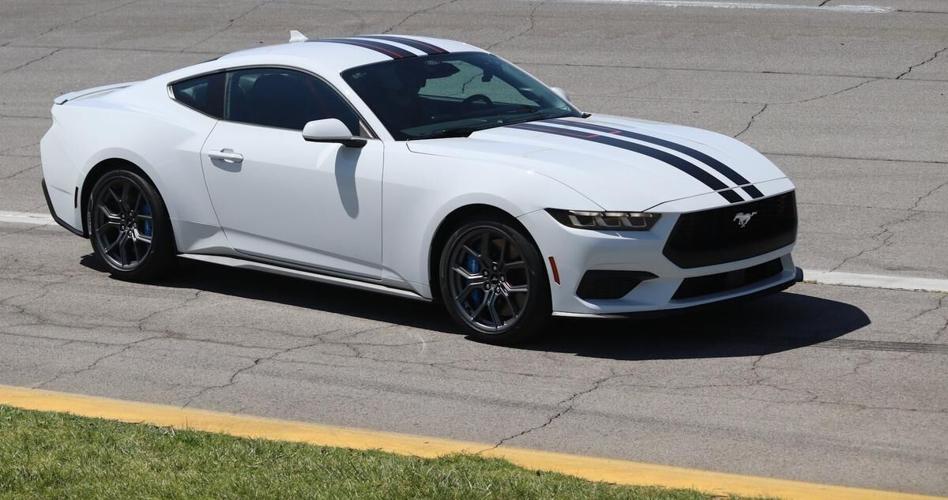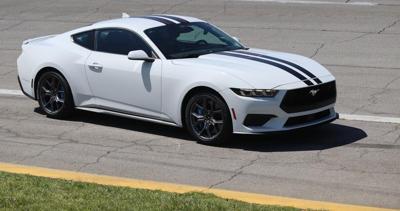2024 Ford Mustang
Type: Two-door, performance, fastback coupe or convertible; front-engine/rear-wheel drive
Engine: 2.3-litre, turbo, four-cylinder; produces 315 horsepower, 350 lbs.-ft . of torque or five-litre, V8, 480 hp, 486 lbs.-ft.
Fuel economy: N/A
Transmission: 10-speed automatic or six-speed manual (GT only)
Cargo: 376 litres (fastback coupe), or 13.27 cubic feet; 291 L (convertible), or 10.27 cu. ft.
Price: $37,000 (four-cylinder), $48,500 (V8)
PASADENA, CALIF.—Nestled about 20 minutes along highway 410, northeast of downtown LA, Pasadena is centred around one main drag. It’s part of Route 66. The perfect place for the Ford Mustang.
Just outside town, there are canyon roads, ideally suited for this iconic car to strut its stuff. The burbling, cracking, spitting noise of the V8 is bouncing off the yellow, rock walls. It feels like I could drive forever here, on these roads, with their bends and shifts in elevation. I can feel the steering transmit the few, slight surface imperfections, the engine’s power pressing against my chest as I rush toward a rare straight, and the surprising composure of the brakes as I set myself up for yet another hairpin from heaven.
California and Mustang just belong together.
The 2024 model year is a big one for the Ford Mustang, as it represents both the debut of the new seventh-generation model as well as the car’s 60th anniversary, making it one of the longest-running nameplates in the automotive world.
This has led to legions of fans. There are Mustang clubs on every continent except Antarctica. They can be pretty specific about what they want changed, what they don’t, or what they want to be able to pick for themselves.
Which is why they will appreciate the rear fascia getting a crease between its upper and lower third, as that recalls the ’67 fastback. They will appreciate the “Fox Body ’87-’93” digital-gauge-cluster option that glows green at night. But ….
Not only is the gauge cluster digitized, but the entire dash is now two separate frameless displays; there’s no longer any supplementary gauges or vents atop the centre stack, and the gauge display is no longer deeply recessed. The dual displays are crisp and the customization is neat, but there was just something so cool and pure about … how it used to look. It was a Mustang signature, that dash, and now that it’s gone, so has some of the interior personality.
But credit goes to Ford on other things: they’ve kept the great short-throw shifter on manual cars and included a flat-bottom steering wheel. Styling upgrades include 12 new wheel styles, a completely redesigned front fascia, more muscular haunches and a larger deck lid spoiler. The three-bar taillamps still get sequential turn signals. Two new colours, Yellow Splash and Vapor Blue, join favourites, such as Race Red and Oxford White, and a Bronze package adds rim colours and badges to fit the name.
Once you sit in either of the two available seat styles, standard, or the more supportive Recaro seats, it’s all good … as long as that proud, long hood fills the windscreen. The seating position is right on, and, even though the Mustang is not a small car, all the controls are nicely within reach, including the manual handbrake on models equipped with the $6,500 Performance Package. This also gets you special summer performance tires, a Torsen limited slip differential (keeps power going to the ground under changing traction conditions), a front strut tower brace, and Brembo brakes with six-piston calipers up front. That package also means you can specify the magnetic ride suspension, which is well worth it, but, at $2,500, it’s a shame it doesn’t come equipped as standard with the Performance Package.
Ford is calling its e-brake a “drift brake,” and it’s developed in partnership with Vaughn Gittin Jr’s RTR drift team. There’s no ratcheting when you use it, which has it feeling more like a motorcycle handbrake and it really does work; turn in, yank it and feel that rear end swivel, ready to be controlled on the throttle. It’s great fun and joins other stuff such as a new remote rev feature, which allows you to remotely start and rev models equipped with the 10-speed auto gearbox.
The drive now feels tauter and more responsive.
I started in the EcoBoost model, which produces 315 horsepower and 350 pounds-feet of torque (motive force), compared to 480 hp and 415 lbs. ft. in the GT. There’s a hint of turbo lag but from then on, you feel it’s a Mustang. The Ecoboost’s powertrain (sends the power from the engine to the axle), mostly delivers, but it’s a shame they’ve killed a manual transmission option for the version with the four-cylinder engine. To get one of those, you have to opt for a GT, where the stick shift is — huzzah! — standard. The clutch take-up is right on, as is the shift linkage; the gearbox is a pleasure to use.
Ford has improved the handling by strengthening the steering column, quickening the steering ratio and adjusting the bushings, for a firmer, more responsive drive. I was pleased to discover that switching to the convertible doesn’t have quite the same softening effect that lopping off the top often does.
The Performance Pack costs a pretty penny, but it does make its presence felt, especially on the small autocross track I spent a handful of laps on. The better brake response is apparent, while the grip provided by the stickier tires is noticeable.
The question is whether or not the Ecoboost’s performance reflects the fact that it costs about 10 grand less to get into than the GT. The difference in straight-line speed is obvious, but such is the Ecoboost’s handling, there’s plenty of fun to be had.
For maximum Mustang, you need to go with the GT. Even with that $10,000 premium over the EcoBoost, it can still be had for less than 50 grand.
Fans will see the new Mustang has kept the vibe of generations previous. It’s got the looks, the power and the handling.
Editor’s note: Please be aware that availability of vehicles depends on supply.

























